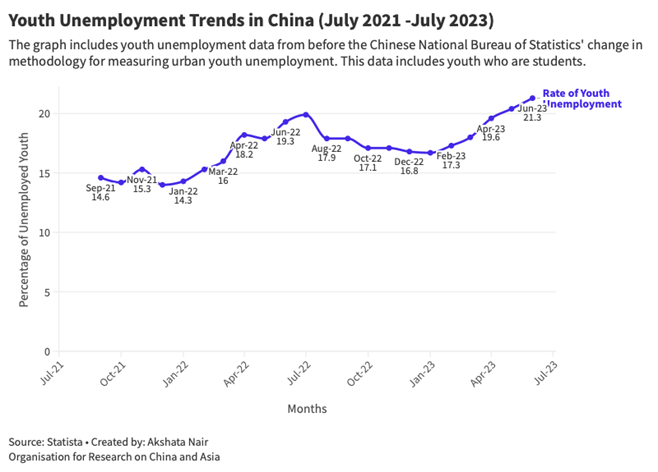China’s Youth Unemployment Conundrum
China’s rising levels of youth unemployment is rapidly turning into a large-scale crisis. This has warranted extensive action by the Communist Party of China (CPC), including an overhaul of policy measures and selective reporting. In June 2023, the National Bureau of Statistics of China stooped releasing regular reports of unemployment which had reached a record high of nearly 21.3 percent. This is in stark contrast with rates from October 2023, when the youth unemployment rate was approximately 18 percent. About a year previous to this, in November 2022, the youth unemployment rate was 16.7 percent. The graph below shows the rapidity with which youth unemployment is growing in China. 
Source: National Bureau of Statistics
- The reports resumed again with the Bureau’s press release in January 2024. The methodology for measuring unemployment had been revised and no longer includes students. Even with this exclusion, youth unemployment in China (people in the age group 16-24), reached at a high of 14.9 percent. Similarly, people in the age group 25-29 have an unemployment rate of 6.1 percent, as of December 2023.
- These higher rates of unemployment have caused concerns for the CPC, especially with newly graduated college students entering the labour force in large numbers every year. In 2024 alone, a staggering 11.9 million university graduates are set to enter the labour force. Needless to say, the CPC has the matter of youth unemployment on a high priority. Thus, this article focuses on the nature of this unemployment and its factors. Finally, it studies and the measures already taken and recently introduced by the CPC.
Structural Unemployment Amongst Chinese Youth
Structural unemployment is a result of industrial reorganisation, something the Chinese economy has undergone over the last five years. The causes for this include technological developments that make certain jobs redundant and others popular, demographic challenges, regulatory crackdowns and cultural expectations. Due to radical changes in industry structure made by technological advances, the pandemic and other above mentioned factors, China’s youth unemployment crisis is in part caused by these structural inaccuracies.
- Disparity between skills and job requirements: Experts across forums believe that the rising youth unemployment is a sign that China is still reeling from the economic consequences of the COVID-19 pandemic. Essentially, there is a gap between the skills possessed by job seekers and the required skills of candidates. This misalignment of skill set, along with the restructuring of the economy (an increased popularity of the tertiary sector) in the light of the pandemic have led to structural unemployment in China. For instance, the number of students with education and sports degrees rose in 2021, but the demand for labour in those industries weakened. This means that the supply of labour in the sports and education industries increased, but demand for workers did not. This is a major supply-side issue resulting in a large number of candidates compete for limited number of jobs.
- Tertiary sector oversupply: China’ service sector, as of 2023, comprised 53 percent of the Gross Domestic Product (GDP). This is significantly smaller than the United States’ 77 percent or United Kingdom’s 72 percent. With the rise in the number of youths with qualifications related to service industries (like delivery services, freelance writing and more), and China’s service sector not being large enough to accommodate them, youth unemployment sees a steep rise.
- Increase in popularity of gig work: Gig employment entails flexible, temporary or freelance jobs and have become increasingly popular amongst Chinese youth. A large number of graduates have taken up freelance jobs or temporary contracts instead of trying to gain permanent employment. Technology has had mixed effects on employment – it is replacing human workers and causing unemployment in some sectors, while creating employment opportunities elsewhere. Thus, low-skilled jobs like that of AI trainers, or gaming “ladders” have become increasingly popular amongst Chinese youth. This flexibility allows the younger workforce to work at their own terms, and escape the conventional 9-9-6 system. Younger workers are choosing to “lie-flat” i.e. work to earn just enough to get by and not engaging in extensive employment. The lack of commitment and flexibility that comes with the gig work is reportedly extremely appealing to the new youth that have entered the workforce. This is another restructuring of supply of labour that is affecting youth unemployment levels in China.
- Demographic challenges: China’s falling birth rate and population issue also plays into the youth unemployment crisis. Particularly, women in the workforce face challenges on both the social front and the professional front. In order to combat the issue of falling population, Xi Jinping has encouraged political federations in China to actively promote new perspectives relating to marriage and childbirth, and implement new policies regarding the same. These policies encourage women to take up a more family-oriented role (as opposed to a career-oriented one) which contradict multiple efforts made in the past to promote women’s share into the workforce. Women with high levels of education see more virtue in their independent life, and are averse to taking up the traditional role of a mother and child-bearer. Furthermore, the former one-child policy has resulted in a demographic majority of male individuals, owing to sex-selective abortions. This, according to a sociology scholar Xiaoling Shu, has resulted in a greater percentage of highly qualified women in the labour force. As of 2022, women accounted for 43.5 percent of the total employed population.
- Regulatory Crackdown: Since 2020, the Chinese government introduced rigid market regulations, especially on the real-estate, Information Technology (IT) and education sectors. These strict measures, experts contend, have had adverse effects on Chinese economic growth, and therefore employment. The economic slowdown following these regulations and high uncertainty led to large-scale redundancies across sectors. E-commerce giant Alibaba, for instance, laid off more than 11,000 workers in 2022 alone. The tight hold on the private sector, which creates most of China’s urban employment, is severely affecting youth employment.
Cyclical Unemployment
Cyclical unemployment is caused by a slowdown in economic activity. As demand for products falls, the demand for workers involved in production also falls. Owing to several issues, including the pandemic, an economic slowdown has contributed towards youth unemployment in China.
- Impact of Prolonged Lockdowns on Small and Medium Enterprises (SMEs): The pandemic severely impacted small and medium sized enterprises, most of which contribute significantly to youth employment. Logistical shocks like disruption of global shipping (caused by piracy, the pandemic, port closures) and irregular electricity supply also contributed towards slowdown and costs. The structural imbalances resulting from regulations and laws also adversely impacted SMEs. For example, in 2021, the government heavily cracked down on China’s off-campus tutoring industry, an industry dominated by SMEs. The slowdown and shutdown of a large proportion of these small and medium enterprises has resulted in the creation of fewer jobs in the workforce.
- Deflationary Pressures: China’s persistent demand-side issues have resulted in contracting Consumer Price Index figures, i.e. falling prices of goods and services. This deflationary trend is indicative of falling demand for products and, as a result, falling employment. The Chinese youths’ employment prospects have been severely affected by these deflationary pressures. According to a report from JP Morgan, China’s revamping of regulations focusing more on production over consumption has caused these deflationary pressures. Resultantly, the falling demand has aggravated Chinese youth unemployment levels.
Measures by the Chinese government to combat the youth unemployment crisis
- Recruitment fairs across China: The Ministry of Human Resources and Social Security (MHRSS), and Ministry of education conducted a three-month long recruitment campaign which ended in April 2024. The campaign entailed distributing over 6.6 billion yuan in subsidies for the organisation of recruitment fairs which created a platform for job seekers and employers to meet. Even more recently, the Ministry of Education launched a 100-day campaign across universities in China to enable large-scale campus recruitment, policy promotions and student visits to enterprises. Minister at the MHRSS, Wang Xiaoping, committed support for SMEs and the development of digital and green industries to boost job-creation.
- Revised guidelines for Gig Economy: Owing to the increasing popularity of the gig economy, the Chinese government issued fresh guidelines to protect the workers and further formalise the industry. These guidelines focus on outlining terms of payment and contracts. The Chinese government has also issued a record 39,600 vacancies for government jobs for the 2024 recruitment season. Compared to 2019 figures, the number government jobs recruitment has doubled. In 2023, the government also offered financial assistance to businesses to increase the number of internship positions and financial assistance to aspiring entrepreneurs who were college graduates. Additionally, in March 2023, vice minister of human resources and social security ministry Li Zhong announced that people could gain access to employment registration facilities through their social security card.
- “One million interns”: The Chinese central government unveiled its “one million interns” plan in 2022. Under this plan, it aspires to make over one million internship positions available in the government for the younger workforce. The joint project includes over 10 ministries, which have promised the internship stipend to cover basic living expenses and insurance. The experience and recommendations gained by the interns are expected to prove as a contributing factor towards bridging the gap between qualification and job requirements.
- City-specific measures: Several cities in China have implemented policies to boost recruitment of college graduates. For instance, employers who hire within a year of the employee’s graduation from Beijing’s colleges gain benefits relating to social insurance reimbursements. Similarly, in Shanghai, hiring an unemployed youth can earn a business a one-time employment subsidy. Other examples include cities like Guangzhou and Tianjin which offer a variety of social insurance, tax exemption, loan disbursement and subsidy related benefits to employers for hiring unemployed youth.
Conclusion
China’s youth unemployment crisis has many causes. The Chinese government has been combating the issue for several years, with varying degrees of success and failure. Unfortunately, the number of unemployed youths far outstrip the number of employment opportunities created by said policies. Furthermore, the cultural factors trace some of the root causes of the crisis to the social fabric of the country. Due to this, the crisis has turned into a chronic problem facing the Chinese economy. Despite multiple efforts being made by the government, the Chinese economy will continue to face this issue for the time being as restructuring of industries and labour force is a change that occurs in the long run.

Author: Akshata Nair, Undergraduate Program

